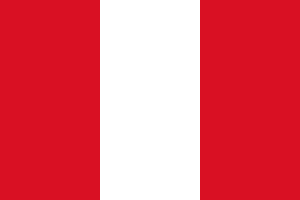
The flag of Chile consists of two equal-height horizontal bands of white and red, with a blue square the same height as the white band in the canton, which bears a white five-pointed star in the center. It was adopted on 18 October 1817. The Chilean flag is also known in Spanish as La Estrella Solitaria.

The National Day of the Republic of China, also referred to as Double Ten Day or Double Tenth Day, is a public holiday on 10 October, now held annually as national day in the Republic of China. It commemorates the start of the Wuchang Uprising on 10 October 1911 which ultimately led to the collapse of the imperial Qing dynasty, ending 2,133 years of imperial rule of China since the Qin dynasty and establishment of the Republic of China on 1 January 1912. The day was once held as public holiday in mainland China during the Mainland Period of the ROC before 1949. The subsequent People's Republic of China continues to observe the Anniversary of the Xinhai Revolution at the same date but not as a public holiday, which put more emphasis on its revolutionary characteristics as commemoration of a historical event rather than celebration to the founding of the Republic of China.
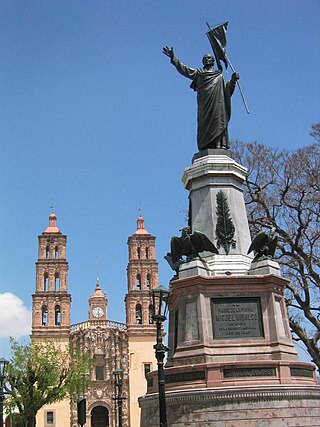
The Cry of Dolores occurred in Dolores, Mexico, on 16 September 1810, when Roman Catholic priest Miguel Hidalgo y Costilla rang his church bell and gave the call to arms that triggered the Mexican War of Independence. The Cry of Dolores is most commonly known by the locals as "El Grito de Independencia".

The flag of Panama was made by María de la Ossa de Amador and was officially adopted by the "ley 48 de 1925". The Panamanian flag day is celebrated on November 4, one day after Panamanian separation from Colombia, and is one of a series of holidays celebrated in November known as the Fiestas Patrias.
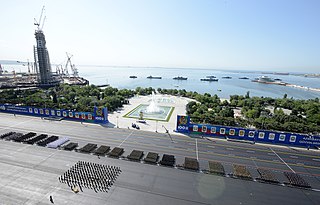
An Armed Forces Day, alongside its branch-specific variants often referred to as Army or Soldier's Day, Navy or Sailor's Day, and Air Force or Aviator's Day, is a holiday dedicated to honoring the armed forces, or one of their branches, of a sovereign state, including their personnel, history, achievements, and perceived sacrifices. It's often patriotic or nationalistic in nature, carrying propaganda value outside of the conventional boundaries of a military's subculture and into the wider civilian society. Many nations around the world observe this day. It is usually distinct from a Veterans or Memorial Day.

Independence Day, known colloquially as the Fourth of July, is a federal holiday in the United States commemorating the Declaration of Independence, which was ratified by the Second Continental Congress on July 4, 1776, establishing the United States of America.

Victory Day is a national holiday in Bangladesh celebrated on 16 December to commemorate the defeat of the Pakistan Armed Forces in the Bangladesh Liberation War in 1971 and the Independence of Bangladesh. It commemorates the Pakistani Instrument of Surrender, wherein the commander of the Pakistani Forces, General AAK Niazi, surrendered to the Mukti Bahini and their Indian allies, ending the nine-month Bangladesh Liberation War and 1971 Bangladesh genocide and marking the official secession of East Pakistan to become the new state of Bangladesh.

Republic Day is a national holiday in India commemorating the adoption of the Constitution of India, and the country's transition to a republic which came into effect on 26 January 1950.

Independence Day is celebrated annually on 15 August as a public holiday in India commemorating the nation's independence from the United Kingdom on 15 August 1947, the day when the provisions of the Indian Independence Act, which transferred legislative sovereignty to the Indian Constituent Assembly, came into effect. India retained King George VI as head of state until its transition to a republic, when the Constitution of India came into effect on 26 January 1950 and replaced the dominion prefix, Dominion of India, with the enactment of the sovereign law Constitution of India. India attained independence following the independence movement noted for largely non-violent resistance and civil disobedience led by Indian National Congress under the leadership of Mahatma Gandhi who adopted these values from one of the early movements in India led by Ram Singh Kuka.
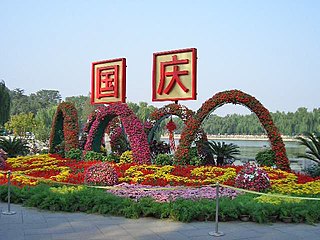
National Day, officially the National Day of the People's Republic of China (中华人民共和国国庆节), is a public holiday in China celebrated annually on 1 October as the national day of the People's Republic of China, commemorating Mao Zedong's formal proclamation of the establishment of the People's Republic of China on 1 October 1949. The Chinese Communist Party victory in the Chinese Civil War resulted in the Kuomintang retreat to Taiwan and the Chinese Communist Revolution whereby the People's Republic of China replaced the Republic of China.

The Fiestas Patrias of Chile consist of two days, with a third one added on some years:
Fiestas Patrias is a Spanish phrase meaning "Patriotic Holidays" or "National Holidays". It may refer to:
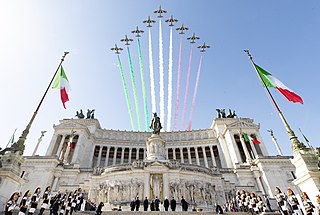
Festa della Repubblica is the Italian National Day and Republic Day, which is celebrated on 2 June each year, with the main celebration taking place in Rome. The Festa della Repubblica is one of the national symbols of Italy.

The Chilean Declaration of Independence is a document declaring the independence of Chile from the Spanish Empire. It was drafted in January 1818 and approved by Supreme Director Bernardo O'Higgins on 12 February 1818 at Talca, despite being dated in Concepción on 1 January 1818. The ceremony of independence was performed on 12 February 1818, the first anniversary of the Battle of Chacabuco.

On July 29 every year, the Grand Military Parade of Peru celebrating the anniversary of Peru's declaration of independence from Spain in 1821 is held in Lima, the national capital, by members of the Peruvian Armed Forces and the National Police of Peru and is presided over by the President of Peru and his First Family, members of the Council of Ministers of Peru and the Congress of the Republic of Peru, other civil officials, ecclesiastical leaders, the Diplomatic Corps of Peru, and other invited guests, among them commanders and other officers and personnel of the Armed Forces and the National Police.

The 16 September military parade in honour of the anniversary of Mexican Independence is an annual tradition dating back to the late 19th century and the beginning of the professionalisation of the Mexican Armed Forces in the 20th century. Held yearly in the Zócalo in Mexico City, this parade, the largest of the various parades held simultaneously nationwide on September 16, Mexican Independence Day, is presided by the President of Mexico in the fulfillment of his duty as the Supreme Commander of the Armed Forces. It is also attended by members of the Cabinet of Mexico, the Congress of the Union, civil service employees, the Secretaries of National Defense and Navy, members of the Mexican Armed Forces, uniformed service veterans, the state diplomatic corps, delegations representing the religious sector, indigenous peoples, sports and the private sector, and the general public. Seen on TV and the Internet and heard on radio, this is one of the biggest events of the year. Taking part in this are members of the Mexican Armed Forces and the National Guard.
Independence Day, known colloquially as October First, is an official national holiday in Nigeria, celebrated on the 1st of October. It marks Nigeria's proclamation of independence from British rule on 1 October 1960.
Independence Day, also known as the Fifth of July is the national independence holiday of Venezuela, marked every year on July 5 which celebrates the anniversary since the enactment of the 1811 Venezuelan Declaration of Independence, making the country the first Spanish colony in South America to declare independence. In recent years, it is also marked as National Armed Forces Day to honor the faithful service of all the serving men and women and veterans of the National Bolivarian Armed Forces of Venezuela.
The following lists events that happened during 2022 in South America.
The Message to the Nation is a political tradition in Hispanic American countries that consists of a speech delivered by the head of state before a representation of the Nation in which the government is rendered accountable at the beginning of the new ordinary legislative period or extraordinary measures are announced.
